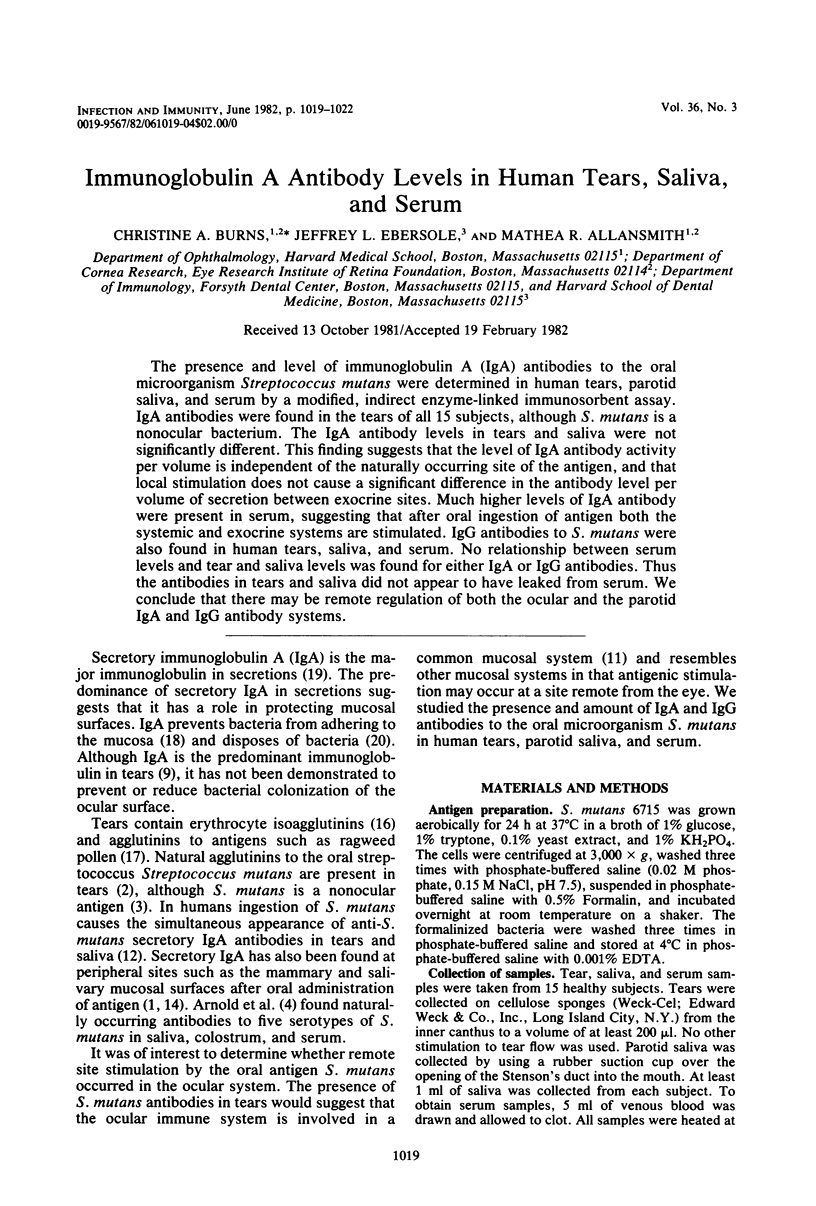Abstract
The presence and level of immunoglobulin A (IgA) antibodies to the oral microorganism Streptococcus mutans were determined in human tears, parotid saliva, and serum by a modified, indirect enzyme-linked immunosorbent assay. IgA antibodies were found in the tears of all 15 subjects, although S. mutans is a nonocular bacterium. The IgA antibody levels in tears and saliva were not significantly different. This finding suggests that the level of IgA antibody activity per volume is independent of the naturally occurring site of the antigen, and that local stimulation does not cause a significant difference in the antibody level per volume of secretion between exocrine sites. Much higher levels of IgA antibody were present in serum, suggesting that after oral ingestion of antigen both the systemic and exocrine systems are stimulated. IgG antibodies to S. mutans were also found in human tears, saliva, and serum. No relationship between serum levels and tear and saliva levels was found for either IgA or IgG antibodies. Thus the antibodies in tears and saliva did not appear to have leaked from serum. We conclude that there may be remote regulation of both the ocular and the parotid IgA and IgG antibody systems.
Full text
PDF



Selected References
These references are in PubMed. This may not be the complete list of references from this article.
- Ahlstedt S., Carlsson B., Hanson L. A., Goldblum R. M. Antibody production by human colostral cells. I. Immunoglobulin class, specificity, and quantity. Scand J Immunol. 1975 Sep;4(5-6):535–539. doi: 10.1111/j.1365-3083.1975.tb02659.x. [DOI] [PubMed] [Google Scholar]
- Allansmith M. R., Burns C. A., Arnold R. R. Comparison fo agglutinin titers for Streptococcus mutans in tears, saliva, and serum. Infect Immun. 1982 Jan;35(1):202–204. doi: 10.1128/iai.35.1.202-204.1982. [DOI] [PMC free article] [PubMed] [Google Scholar]
- Allansmith M. R., Ostler H. B., Butterworth M. Concomitance of bacteria on various areas of the eye. Arch Ophthalmol. 1969 Jul;82(1):37–42. doi: 10.1001/archopht.1969.00990020039009. [DOI] [PubMed] [Google Scholar]
- Arnold R. R., Mestecky J., McGhee J. R. Naturally occurring secretory immunoglobulin A antibodies to Streptococcus mutans in human colostrum and saliva. Infect Immun. 1976 Aug;14(2):355–362. doi: 10.1128/iai.14.2.355-362.1976. [DOI] [PMC free article] [PubMed] [Google Scholar]
- Crawford J. M., Taubman M. A., Smith D. J. Minor salivary glands as a major source of secretory immunoglobin A in the human oral cavity. Science. 1975 Dec 19;190(4220):1206–1209. doi: 10.1126/science.1198107. [DOI] [PubMed] [Google Scholar]
- Engvall E., Perlmann P. Enzyme-linked immunosorbent assay, Elisa. 3. Quantitation of specific antibodies by enzyme-labeled anti-immunoglobulin in antigen-coated tubes. J Immunol. 1972 Jul;109(1):129–135. [PubMed] [Google Scholar]
- Genco R. J., Taubman M. A. Secretory gamma-A antibodies induced by local immunization. Nature. 1969 Feb 15;221(5181):679–681. doi: 10.1038/221679a0. [DOI] [PubMed] [Google Scholar]
- McClellan B. H., Whitney C. R., Newman L. P., Allansmith M. R. Immunoglobulins in tears. Am J Ophthalmol. 1973 Jul;76(1):89–101. doi: 10.1016/0002-9394(73)90015-9. [DOI] [PubMed] [Google Scholar]
- McDermott M. R., Bienenstock J. Evidence for a common mucosal immunologic system. I. Migration of B immunoblasts into intestinal, respiratory, and genital tissues. J Immunol. 1979 May;122(5):1892–1898. [PubMed] [Google Scholar]
- Mestecky J., McGhee J. R., Arnold R. R., Michalek S. M., Prince S. J., Babb J. L. Selective induction of an immune response in human external secretions by ingestion of bacterial antigen. J Clin Invest. 1978 Mar;61(3):731–737. doi: 10.1172/JCI108986. [DOI] [PMC free article] [PubMed] [Google Scholar]
- Mestecky J., McGhee J. R., Michalek S. M., Arnold R. R., Crago S. S., Babb J. L. Concept of the local and common mucosal immune response. Adv Exp Med Biol. 1978;107:185–192. doi: 10.1007/978-1-4684-3369-2_22. [DOI] [PubMed] [Google Scholar]
- Michalek S. M., McGhee J. R., Mestecky J., Arnold R. R., Bozzo L. Ingestion of Streptococcus mutans induces secretory immunoglobulin A and caries immunity. Science. 1976 Jun 18;192(4245):1238–1240. doi: 10.1126/science.1273589. [DOI] [PubMed] [Google Scholar]
- Ogra P. L., Karzon D. T. Distribution of poliovirus antibody in serum, nasopharynx and alimentary tract following segmental immunization of lower alimentary tract with poliovaccine. J Immunol. 1969 Jun;102(6):1423–1430. [PubMed] [Google Scholar]
- SETTIPANE G. A., CONNELL J. T., SHERMAN W. B. REAGIN IN TEARS. J Allergy. 1965 Jan-Feb;36:92–96. doi: 10.1016/0021-8707(65)90036-5. [DOI] [PubMed] [Google Scholar]
- Svanborg-Edén C., Svennerholm A. M. Secretory immunoglobulin A and G antibodies prevent adhesion of Escherichia coli to human urinary tract epithelial cells. Infect Immun. 1978 Dec;22(3):790–797. doi: 10.1128/iai.22.3.790-797.1978. [DOI] [PMC free article] [PubMed] [Google Scholar]
- TOMASI T. B., Jr, ZIGELBAUM S. THE SELECTIVE OCCURENCE OF GAMMA-1A GLOBULINS IN CERTAIN BODY FLUIDS. J Clin Invest. 1963 Oct;42:1552–1560. doi: 10.1172/JCI104840. [DOI] [PMC free article] [PubMed] [Google Scholar]
- Williams R. C., Gibbons R. J. Inhibition of bacterial adherence by secretory immunoglobulin A: a mechanism of antigen disposal. Science. 1972 Aug 25;177(4050):697–699. doi: 10.1126/science.177.4050.697. [DOI] [PubMed] [Google Scholar]


